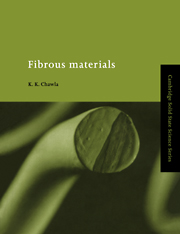Book contents
- Frontmatter
- Contents
- Preface
- Acknowledgments
- Chapter 1 Introduction
- Chapter 2 Fibers and fiber products
- Chapter 3 Natural polymeric fibers
- Chapter 4 Synthetic polymeric fibers
- Chapter 5 Metallic fibers
- Chapter 6 Ceramic fibers
- Chapter 7 Glass fibers
- Chapter 8 Carbon fibers
- Chapter 9 Experimental determination of fiber properties
- Chapter 10 Statistical treatment of fiber strength
- References
- Suggested further reading
- Appendix A Some important units and conversion factors
- Author index
- Subject index
Chapter 3 - Natural polymeric fibers
Published online by Cambridge University Press: 13 October 2009
- Frontmatter
- Contents
- Preface
- Acknowledgments
- Chapter 1 Introduction
- Chapter 2 Fibers and fiber products
- Chapter 3 Natural polymeric fibers
- Chapter 4 Synthetic polymeric fibers
- Chapter 5 Metallic fibers
- Chapter 6 Ceramic fibers
- Chapter 7 Glass fibers
- Chapter 8 Carbon fibers
- Chapter 9 Experimental determination of fiber properties
- Chapter 10 Statistical treatment of fiber strength
- References
- Suggested further reading
- Appendix A Some important units and conversion factors
- Author index
- Subject index
Summary
Commercially, polymeric fibers are perhaps the most important of all, covering as they do a vast range of applications. There are two broad categories of polymeric fibers: natural and synthetic. Natural fibers can be from the vegetable kingdom such as cotton, sisal and jute or from the animal kingdom such as wool, silk, etc. Natural fibers are mostly polymeric in nature. There are, however, some natural fibers that occur in rock formations. These fibers are minerals and can therefore be treated as a ceramic, e.g. asbestos and basalt. We describe these natural mineral fibers in Chapter 6. In this and the following chapter, we describe polymeric fibers. We first briefly review some of the fundamental aspects of polymers and then describe the natural polymeric fibers. We devote Chapter 4 to the synthetic polymeric fibers, which have seen tremendous advancement in the last half of the twentieth century. A vast range of natural polymeric fibers is available and they find large-scale commercial applications. Much research effort is focused on a very special natural fiber originating in the animal kingdom, spider silk. The idea here is to learn about the processing, structure, and properties of silk fibers which are very strong and stiff. More about this later in this chapter. The volume of other natural fibers such cotton, jute, sisal, ramie, etc. in industrial and non-industrial applications has always been quite large because of their many attributes such as the wear-comfort of cotton and the fact that all natural fibers represent a renewable resource.
- Type
- Chapter
- Information
- Fibrous Materials , pp. 37 - 57Publisher: Cambridge University PressPrint publication year: 1998



